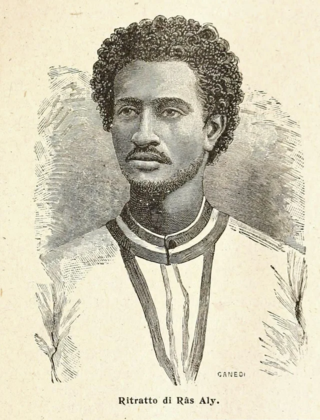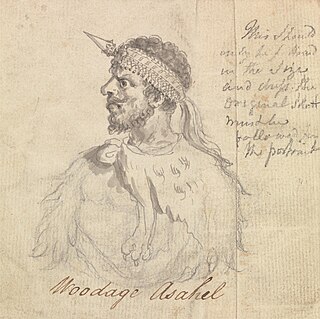| Ras Goshu Zewde | |
|---|---|
| Prince of Gojjam | |
| Reign | 1825-1852 |
| Predecessor | Zewde |
| Born | 1783 or 1788 |
| Died | November 1852 (aged 64-69) |
| Spouse | Woizero Sahlitu Inqu |
| Issue | Lij Dori Birru Goshu Tessemma Goshu Negussie Goshu |
| Father | Dejazmach Zewdie Silin |
| Mother | Woizero Dinnkénesh Hailu |
| Religion | Ethiopian Orthodox Tewahedo |
Goshu Zewde of Gojjam (1783 or 1788-1852) was the governor of Damot, Metcha and Ybaba; most of Gojjam was, indeed, under the government of his son Birru Goshu.
He was elevated to the personal titles of Dejazmach in 1825 and Ras by Emperor Sahle Dengel in 1848.
Goshu Zewde belonged through his mother, Woizero Dinnkénech to the imperial family: she was the granddaughter of Walata Israel, daughter of Empress Mentewab by her first husband and half-sister of Emperor Iyasu II. [1] His father, the Dejazmach Zewde, of Oromo origin [2] [3] and Governor of Damot, had died captive of Ras Gugsa, against whom he had fought for several years. The Dejazmach Goshu, although reduced to the government of Damot, Metcha and Ybaba, was still formidable. Princes, churchmen and farmers all held him in high esteem, as much for his high birth as for the goodness of his character.

Lik Atsqu, a scholarly high dignitary who was one of the four great imperial judges of Ethiopia, describes Goshu as a great ruler: [4]
This prince is an honest, intelligent, generous Christian. He is a true prince, unlike the bandits you have encountered so far. The house of Gugsa is a den of usurpers and renegades; the house of Goshu Zawde is built on tradition, law and justice.
The French explorer Arnaud d'Abbadie, who was a close friend of the Goshu described him thus: [5]
Dedjadj Goshu, who was about fifty years old, had an imposing height and build, he was fat without being obese, but his lower body seemed lean compared to his powerful chest. His wrists and ankles were thin, and he had a feminine elegance in his hands. He had a copper-brown complexion, a voluminous head, gracefully set on a long neck with a rare beauty of outline for a man. His broad, high, and bulging forehead was complemented by delicately drawn temples, a small nose with movable wings, and large eyes à fleur de tête. His upper lip was covered in a light fuzz, his teeth were small and pearly, his chin was short and fine with dimples. His cheeks were flat, broad, and without beard.
The carriage of his head and his slightest movements were gently dominant; his reserved gaze suggested a certain self-complacency. Although his intelligent physiognomy was veiled by that impassivity which befits the exercise of great power, one discovered a great kindness, shy rather than active, finesse, playfulness, indecisiveness combined with stubbornness, the spirit of adventure, fearlessness and a melancholic doubt that often affects those responsible for events and men.
His carefully draped toga revealed three long necklaces made of periapts or talismans covered in red morocco or vermeil, interspersed with grains of coral, amber or rare glassware. On his little finger he wore a gold ring made up of three interlocking rings, each set with an emerald; this beautifully crafted antique jewel came from India. A long gold pin, ending in a filigree ball, was threaded through his black, bushy, wavy and corymb hair; as a Waïzoro, he wore periscelis of small threaded gold cones on his ankles...
Dejazmach Goshu was a governor loyal to Ras Ali; he actively participated in many battles during the "Zemene Mesafint". However, he found death during the Battle of Gur Amba against the troops of Kassa Hailu future Tewodros II. [6]









